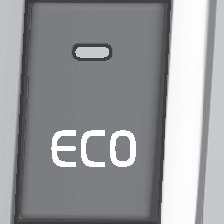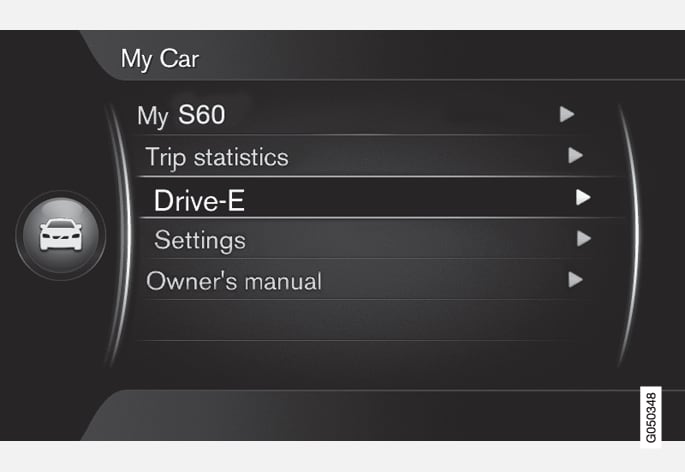General

The following are changed upon activation of the ECO function:
- Gearbox gearshift points.
- Engine management and response from the accelerator pedal.
- Start/Stop function - the engine can also auto-stop before the car has stopped down to being completely stationary.
- The Eco Coast function is activated - engine braking ceases.
- Climate control system settings - some electricity consumers are deactivated or operate at reduced power.
Note
ECO - Operation

 ECO On/Off
ECO On/Off ECO symbol
ECO symbol
The ECO function is deactivated when the engine is switched off, and must therefore be activated after each time the engine is started. There are exceptions for certain engines. However, it is easily verified by means of both the combined instrument panel ECO symbol and the ECO button lamp illuminating when the function is activated.
ECO function On or Off


Disengaged ECO function is indicated by the combined instrument panel ECO symbol and the ECO button lamp extinguishing. The function is then switched off until it is reactivated with the ECO button.
Eco Coast - Function
The Eco Coast subfunction means in practice that engine braking is deactivated, meaning in turn that the car's kinetic energy is used to coast for longer distances. When the driver releases the accelerator pedal the gearbox is automatically disengaged from the engine whose speed is reduced to idling speed with minimum consumption.
This function is intended for use in the event of an anticipated reduction in speed, e.g. to coast forward to an intersection or a red light.
Eco Coast enables proactive driving where the driver can use the so-called "Pulse & Glide" technique and a minimum of braking.
Combination On and Off
A combination of Eco Coast and temporarily deactivated ECO function can also collectively contribute to reduced consumption. Accordingly:
- Active Eco Coast: Long coasting without engine braking = Low consumption
and
- Deactivated ECO function: Short coasting with engine braking = Minimum consumption.
Note
Activating Eco Coast
The function is activated when the accelerator pedal is fully released, in combination with the following parameters:
- ECO button activated
- Gear selector in D position
- Speed within the range of approx. 65-140 km/h
- The road's downhill gradient is not steeper than approx. 6%.
Deactivate Eco Coast
In certain situations it may be desirable to deactivate the Eco Coast function. Examples of such situations include:
- on steep downhill gradients - to be able to use engine braking.
- before an imminent overtaking manoeuvre - in order to be able to complete it in the safest possible way.
Deactivating Eco Coast and returning to engine braking can be performed as follows:
- Press the ECO button.
- Move the gear lever to manual "S+/-" position.
- Change gear with the steering wheel paddle shifters.
- Actuate the accelerator or brake pedal.
Eco Coast - Limitations
The function is not available if:
- cruise control is activated
- the road's downhill gradient is steeper than approx. 6%
- manual gear changing is performed with the steering wheel paddle shifters*
- engine and/or gearbox are not at normal operating temperature.
- the gear selector is moved from D- to "S+/-" position
- speed is outside the range of approx. 65-140 km/h
More information and settings

The car's menu system MY CAR contains further information on the ECO concept - see the section MY CAR.